KONZ IN THE AREA OF ART & CULTURE
By designing numerous squares, roundabouts, etc. in the city area conc made a name for itself in recent years. Well-known artists have significantly shaped the cityscape with their work.
SILVER SUN
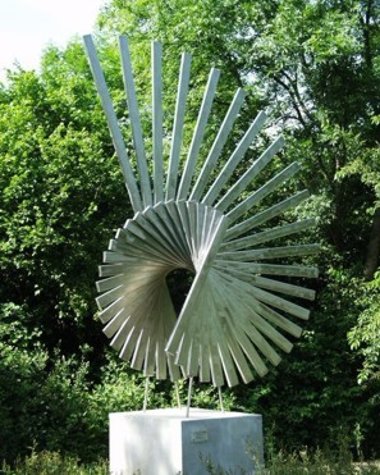
Plastic made of stainless steel
by Max Bodzin, 2003Location: entrance to Konz-Karthaus
Dimensions: 510 cm high, 105 cm wide, weight: 420 kg
Material: stainless steel V4A, rustproof, non-magnetic, maintenance-free inert gas welded construction, storm-proof on a concrete base.
Surfaces in vibratory grinding, polished to a satin finish Production in our own workshop in Wincheringen.
Erection by crane transport.
"...future-oriented work of art of great aesthetics, which does not furnish its location, but rather marks it in the long term." (quot.)
THE FAT WOMAN
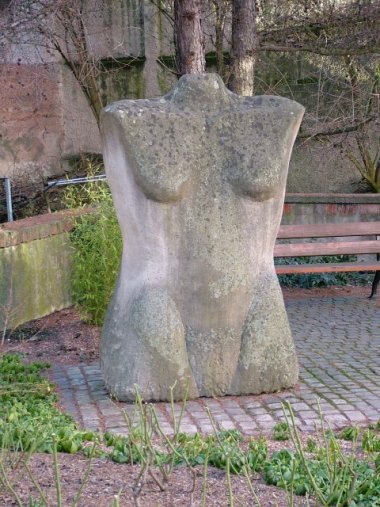
stone sculpture
from Joseph Lambertz , 1996May 23, 1942 born in Wiltingen, died September 25, 2001
"Is created in a difficult personal situation of the artist."
Location: Schillerstrasse opposite the health center
SCULPTURES ROUNDBOUND
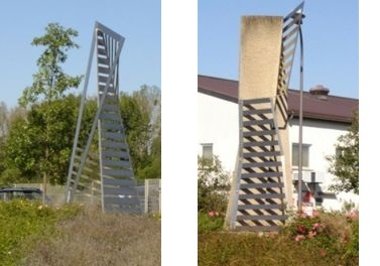
Sandstone with stainless steel
from Isabelle Federkeil , 2000
Location: Konz-Könen, former B 51 towards Saarburg
In my sculptures I deal on the one hand with the formal language of our industrial society and on the other hand with the archaic power of the natural material stone. The connection between stainless steel and sandstone creates an exciting dialogue between biological creation and artefact. The special feature of the location, traffic roundabout, is reflected in the theme of the sculpture.It's about movement about speed, the phenomenon of our time. Here the movement is represented in the form of a kind of rotation. The twisted shape of the stone is continued in the movement of the two wing-like stainless steel parts. The impression is given that the sculpture is rotated by the movement of the cars driving around it. It is the starting point and variation for the rotational movement of the second spinning top sculpture.
Source:
Isabelle Federkeil "Notes on my artistic work"- About the artist: Isabelle Federkeil
SANDSTONE
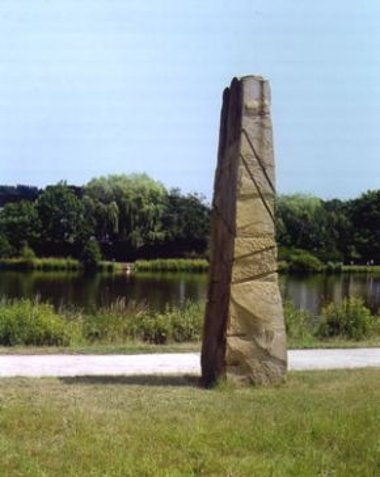
by Isabelle Federkeil, 1999,
Sculpture symposium in Oberbillig
Location: Saarufer Konz - direction KönenSince time immemorial, man has been interfering with nature, changing it according to his ideas, cultivating and destroying it. I try to express this intervention through my sculpture. The surface of the block of stone is untreated, rough as nature created it. In contrast, the deeply incised graphic lines appear like injuries - archaic traces of the human effort to change.
Source:
Isabelle Federkeil, Brochure "Stones by the River"DISPOSAL POINTS
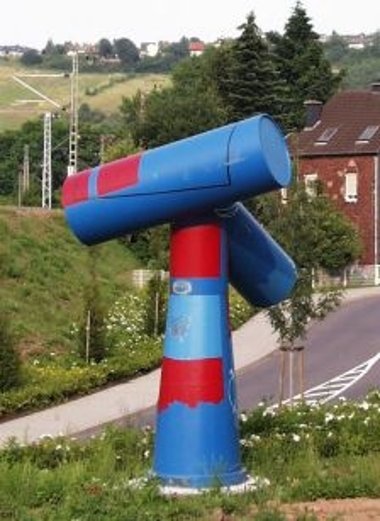
plastics
by Prof. Friedrich Gräsel, 1983
Location: Querspange/Luxemburger DammThe three disposal marks are three variations on a blueprint depicting the three directions of levitation: up, down, and horizontal. The colored basic versions differentiate between two blue and one red large form. All three are painted with signs and signals that come from the everyday technical world. They signal attention. This attention culminates in the four lines of text of the Four Powers Peace Appeal: Peace instead of victories! The three works are also in a dialogue with the new traffic-related environment. They play around the given floor modulations and enrich the urban space with an aesthetic sensation that invites you to look and linger.
CONCERT DOCTOR FOUNTAIN
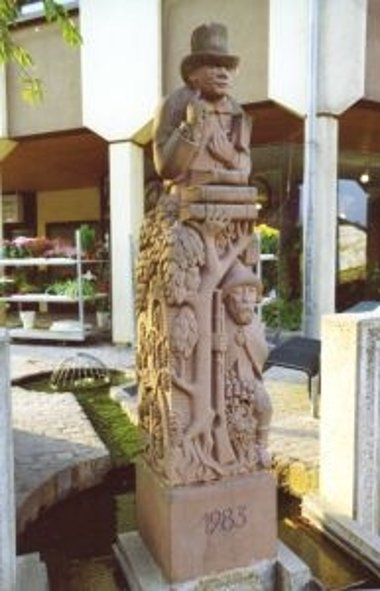
fountain site
by sculptor Willi Hahn, 1984
Location: Wiltinger Strasse / corner of MartinstrasseThe "Konzer Doctor" is the symbol of Konz.
In addition to the Fotschelgeist or the Breester smoker, the sandstone figure also shows other legendary figures from the surrounding area.
The main theme, however, is the historical figure of the Konzer pastor and schoolman Georg Canaris (1740-1819), who trained the Konzer in such a way that they still have the nickname "Konzer Doctors" due to their educational advantage compared to other villages.
STONE AT THE SAAR MOUTH
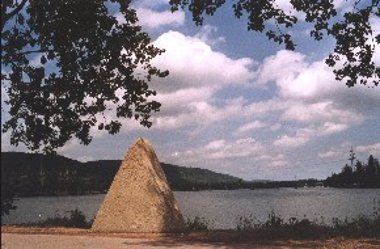
sandstone
Christopher Manke , 1999,
Sculpture symposium in OberbilligAn estuary is a special place. A stone was created for the mouth of the Saar that rests in itself thanks to its triangular shape. Facing the estuary, the recessed silhouette allows the stone to sit or stand. It is quieter in the stone, the sound of the water is amplified.
It is a place to come to rest. A place of reflection.Source: Christoph Mancke, Brochure "Stones by the River"
PROFAN WALL PAINTINGS
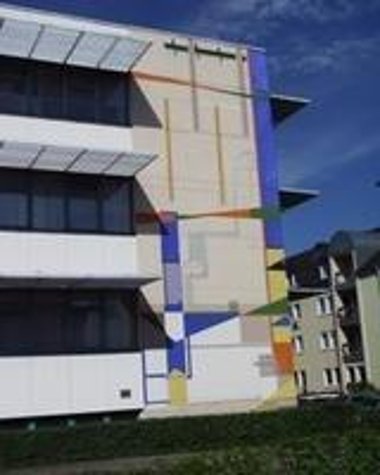
by George Meisterman
VHS / City Library, Konstantinstraße 50
(former administration building of the company Zettelmeyer )Functional building from the post-war period, paintings on the facade surfaces and in the reception room from 1969, reworked in 1989 after damage due to age, partly changed.
Main theme: energies of construction. Artistic attempt to develop the pictorial forms as "art out of the building" (Stachelhaus), i.e. from the structural engineer's understanding of the building. The starting point are elements and connections that can only be seen on the shell (mats, iron reinforcements, wall profiles, etc.). For the artist, they are like the "muscles and nerves" that allow him to visualize the tension in the static structure: the pressure and tensile forces, the weight of the floors, the climatic effects. The choice of colors also follows this idea. The main composition seems inspired by the idea of an X-ray. The opposite facade wall shows the forces resisting the wind pressure. The motif of a joyful rhythmic play of lines on a narrow wall part is due to the grille of the sun visors. Business life is signaled by the winding ascent of a meander on the stairwell wing. The colorful framework of the ribbon windows connects the facade painting distributed in four places and originally made the building a "single picture".
Swell:
Lit.: Mayers, Norbert: The altar wall by Georg Meistermann in the parish church of Konz, St. Nikolaus., in: Commemorative publication "10 years of Gymnasium Konz 1973 1983", p.75 82 ds.: Tent of God. The parish church of Konz St.Nikolaus. , in: Catholic parish church Konz St. Nicholas. Contributions and documents on the history of the parish, the church building and the Roman villa., Konz 1986, p Zettelmeyer in Konz, in: 2003 yearbook of the district of Trier Saarburg, p Prof. Georg Meistermann on his assignment., in: Die Dampfwalze, company journal of the Hubert Zettelmeyer company, Konz, issue 42/1970, p.38 f.SACRED WALL PAINTINGS
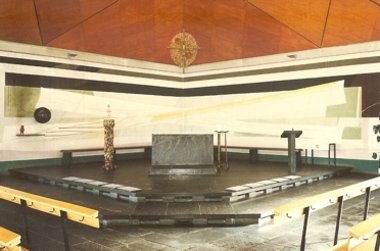
by George Meisterman
Parish Church of St. Nicholas
(Architect: Hermann Baur, Basel, 1959, painting 1969):a) Altar wall, 3.45 x 18.50 m, motif: spirit symbol. The building idea "God's tent among men" (Apoc. 21,3) is brought to completion through the painting. The wall is no longer there, so to speak. Floating surfaces, as if swept by the wind, conceal an unfathomable depth. Two bright, wing-like curved bands of color emerge from it, embracing the altar. The erratic displacements in the structure of the lines and surfaces, the waves and radiant forms are felt as spiritual energies. The work is one of the earliest of Meistermann's "wings" and is unique in its monumental and geometric form, whose elements follow the specifications of the architecture.
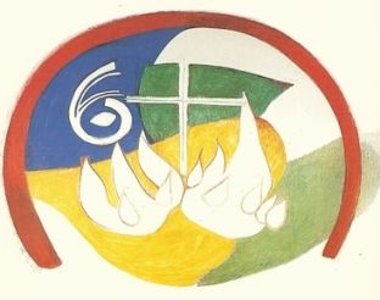
b) Crypt: The strong fields of color on the walls and ceiling form a space-expanding, extremely lively counter-architecture. The central form is the "symbolon", a symbol of the Trinity developed by the artist and frequently used by him, here in a particularly aesthetically pleasing variant. The framed charcoal drawing on the right-hand wall showing the appearance of the Risen One through the closed door is a design for a glass window that Meistermann created in 1962/63 for the St. Theresienkirche in Linz/Donau.
Swell:
Lit.: Mayers, Norbert: The altar wall by Georg Meistermann in the parish church of Konz, St. Nikolaus., in: Festschrift "10 years of Gymnasium Konz 1973 1983, p.75 82 ds.: Tent of God. The parish church of Konz St.Nikolaus., in: Catholic parish church of Konz St.Nikolaus. Contributions and documents on the history of the parish, the church building and the Roman villa., Konz 1986, p. 25 48 ds.: Bild und Bau.
Georg Meistermann's paintings on the former administration building of the Hubert Zettelmeyer company in Konz, in: 2003 yearbook of the Trier Saarburg district, p. 110 114 Georg Meistermann, monograph and catalog raisonné / Karl Ruhrberg, Werner Schäfge (1 ed.). With contributions from Inge Herold Cologne: Wienand 1991, p.233 238 Prof. Georg Meistermann on his assignment., in: Die Dampfwalze, company journal of the Hubert Zettelmeyer company, Konz, issue 42/1970, p.38 f.THE BERENDSBORN
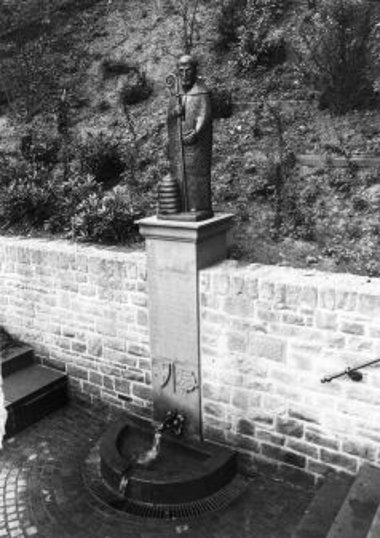
Overall planning: Rudolf Molter
Bronze figure: Silvio Dell'AntonioAt a place steeped in history, the court boundary between the electoral offices of Saarburg and Trier, which was probably established more than 650 years ago - at the "white Wacken" and at the Berendsborn spring - there was a traditional washing fountain for the village of Konz until around 1900. The relics of this facility were in the Over time, especially during the construction of the west wall systems there, as well as in the war and post-war period and after the founding of the Berendsborn district (1949), it has become a primitive "water hole".
On the initiative of some Konz-Berendsborn citizens, the city of Konz carried out a comprehensive redesign of the spring and its surroundings in 1989, according to the plans of the architect and city council member R. Molter. The focal point of the complex is the figure of “St. Bernhard with the beehive.” The representation as monk and abbot Bernhard von Clairveaux (1090-1153) refers to the naming of St. Bernhard as “doctor mellifluus” (= “honey-flowing” doctor), as a reference to his convincing, “how Honey flowing speech"... Arriving over the Konzerbrück from Burgundy, he founded the Abbey of Himmerod. The first mention of the group "Bernhardts Boren oben Contz" results from a Himmerode document from the year 1566.
The bronze figure is the work of the Wittlich sculptor Silvio Dell' Antonio. The spout, designed as a mythical animal, comes from the workshop of R. Kopp, Oberemmel, like the other wrought iron works. The electoral coat of arms of Trier on the one hand and the court rose of the Saarburg office on the other hand on the fountain column refer to the text handed down in a document from the electoral year thing of the year 1574, that..." in the event that an unlawful person is seized on the other side of the Bernhardsborn, the same should go to Saarburg , and since one of the subjects would be taken to Kuntz, the same would be led to Pfalzel (as places of jurisdiction).
PLAY SCULPTURES
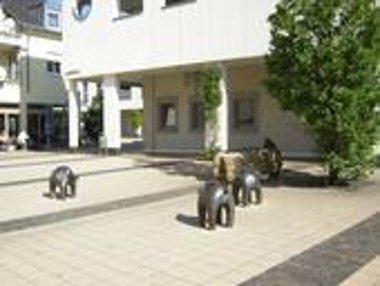
bronze sculptures
Liesel Metten, 2000Sculptor from Mainz, has made a name for herself in Rhineland-Palatinate with her quaint animal sculptures in public squares and schoolyards. She created the bronze figures for children to play with.
The SNIFFING ANIMALS circle the water-dispensing fountain trough and encourage the children to climb and linger and the adults to smile.DANCER COUPLE

bronze
by Karlheinz Oswald
Location: Roundabout B 51 / Möbel MartinIn the center of a newly created roundabout, 2 life-size bronze dancers complement the appearance of the city of Konz. On 3 m high, light-colored rocks, they become part of the panorama between city, country and Moselle. The stones selected from a nearby quarry support the expressiveness of the figures in their natural form. The two dancers are present with their sweeping silhouettes. A lively surface makes the design process visible. In their movements, the figures embody the tension of the dance between turning away and turning towards, detachment and merging. They demand dialogue.
Karlheinz Oswald
BLUE PILLAR
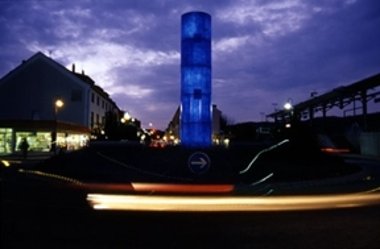
Plastic made of fiberglass
Harald Pompl , 2000ROUNDABOUT AT KOKSIJDER PLATZ
The 7 m high column made of ultramarine blue colored fiberglass accentuates the roundabout. Five column drums of the same size, each with an angle of inclination of approx. 5°, are placed one on top of the other, giving the impression that they are slightly tilted in all directions. The individual drums are optically held together by plaster-like connections. Internal lighting also creates a concise visual indication for road users at night.
The design of this roundabout is part of an overall concept and refers to the local Roman past. The "blue pillar" as a reference to the building activity, the temple.
RED HIRE (DONUT)
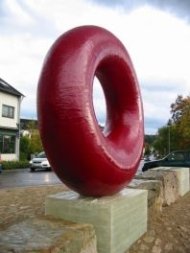
fiberglass plastic,
Harald Pompl , 2005Granastraße/Saarbrücke roundabout
Reinterpreting parts of Roman history through modern sculptures.
This task inspired me to ask how the important traffic junction at the Saarbrücken head could be given a new design. Thankfully, the Wacht family was able to provide us with four Roman stones from the Saar expansion. They could either be "part of the ford" or "the former Roman bridge". These four Roman stones are placed in a line over the inner surface of the roundabout, which is designed with armourstone, so that they symbolically take up the old Roman road on this foundation, which was already used in Roman times. They are complemented in one line by three newly added stones made of transparent fiberglass. The arrangement of the stones on the roundabout leads back to our time. A "tire" (diameter 2.70 m) in a distinctive shade of red (purple as the Roman color) in the center symbolizes this movement or traffic on this old and new path. I am particularly fascinated by conveying history to the present day through artSource:
Brochure "Konzer Saarbrücke" This comprehensive brochure contains a wealth of graphics and previously unpublished photos. It can be obtained for 3 euros from the Konz municipal association, town hall, room 19 and in the “ Kolibri ” bookshop on the market square in Konz.Photo: RWE Rhein-Ruhr
THE FIELD OF EARS
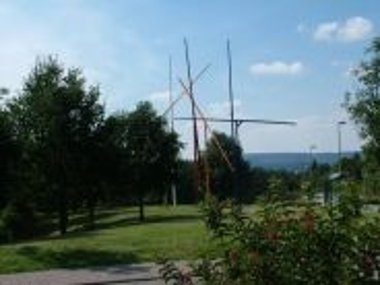
from Harald Pompl
The third work of art by sculptor Harald Pompl was erected on the Roscheiderhöhe. Six sticks that have a height of up to 16 meters and are painted in six bright colors are intended to remind of the grain field that prevailed here.
THE CIRCLE
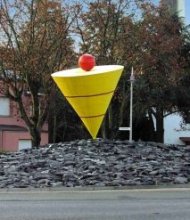
Stainless steel, fiberglass with pigments
from Harald PomplSchillerbrücke/Paul-Magar-Platz roundabout
A roundabout (on top of the roundabout) in the shape of a toy, as used by children in Roman times, adorns the roundabout at Rewemarkt. It appears to follow the movement of the vehicles circling around it, and the driver himself moves twice as much. A game with rotating dynamics, exaggerated by the red spherical button; the colors yellow and red as highly visible signal colors and popular colors for children's toys. The 12-degree incline in the arrangement of the sculpture suggests permanent movement.
At night the sculpture is illuminated from the outside.
THE CUBE
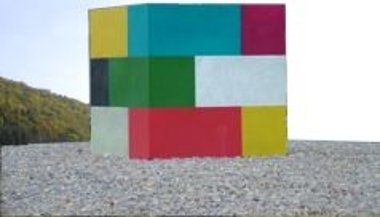
Fiberglass, pigments, stainless steel bolts and nuts
from Harald PomplRoscheider Strasse/Lidl roundabout
Twelve different colored modules or building blocks of the same size form the Roscheider Cube. The individual elements are put together and arranged like bricks in a wall. The colorful variety of parts reflects the variety of building in Konz-Roscheid, a colorful collection of individual building possibilities.
At night, the cube is illuminated from within and shines like a crystal.
The shape and structure of the individual modules evoke associations with the magic cube for children, which can be twisted on all levels; a movement not only in the horizontal but also in the vertical! Also on the roundabout?
CONCERT DOCTOR HAT
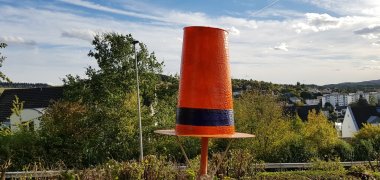
The 7th sculpture by Harald Pompl in Konz:
the group doctoral hatColorful and luminous, the seventh sculpture by the artist Harald Pompl rises above the KONZER-DOKTOR vineyard in Konz-Roscheid. The doctoral hat, the new symbol for the Konzer Doctor, was unveiled on September 21, 2018. The Konzer Doctor, which has always been a symbol of education and social commitment in Konz, was complemented by the modern doctoral hat designed by the artist Harald Pompl.
The sculptor's "public" art, which undoubtedly characterizes the Konz cityscape, always creates a connection between the work and the location, between the visual language of the art and the history and reality of the city's culture. The claim of the artist, who wants the viewer to be able to immediately recognize what he sees, was certainly also achieved with his seventh sculpture in the city of Konz.
In the vineyard above Konz, the doctoral hat in the foundation colors red, orange and blue is intended to draw attention to the Konzer Doctor Civic Foundation, a foundation that serves to promote, train and integrate young people. The sculpture, made of polyester resin reinforced with fiberglass, Pompl's favorite material, timelessly combines past and present, referring at the same time to place and history and without folklorism.
HEAD HEART HAND
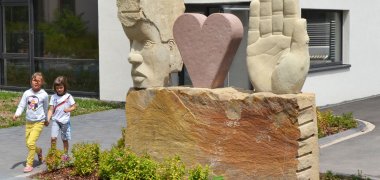
sandstone sculpture
by Juergen Waxweiler, 2014Location:
Elementary school St. Johann in Konz-KarthausEducation and upbringing have a long tradition on the premises and in the vicinity of the Karthaus monastery. With his sculpture, the artist tries to address this genius loci.
Inspired by the head-heart-hand principle of the educator Johann Heinrich Pestalozzi:
“Man becomes man by forming his heart, his craftsmanship and his mind. That should eventually empower people to help themselves.”
Jurgen Waxweiler
HEAD HEART HAND
(after a quote by JH Pestalozzi)
Sculpture for the St. Johann elementary school in Konz-Karthaus
2013-14, sandstone, L. 280 x W. 100 x H. 250 cm
Photo: VG Bildkunst - courtesy of Jürgen Waxweiler
